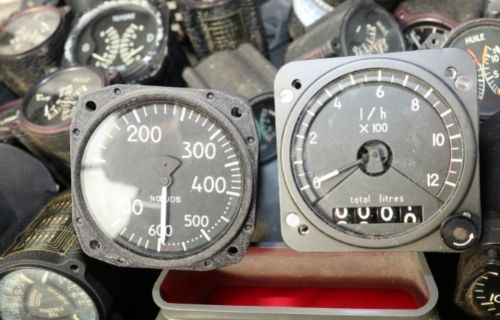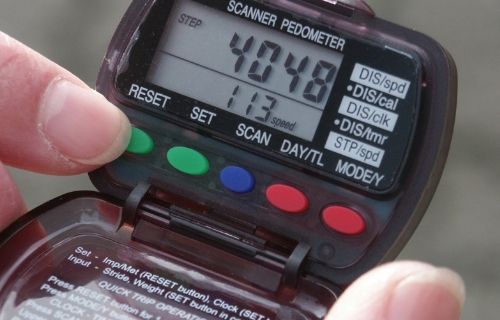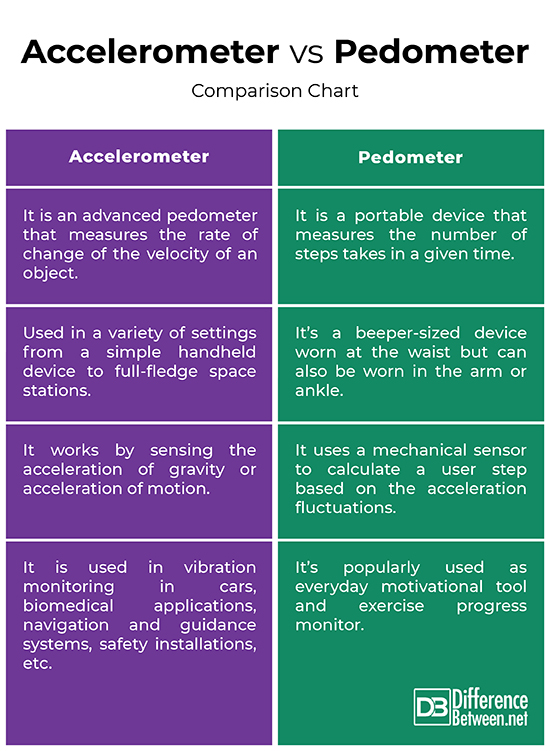Difference Between Accelerometer and Pedometer
Ever wonder what’s the difference between a pedometer and an accelerometer? A pedometer is a step-counting electromechanical device that, as the name suggests, counts the number of steps taken in a given time. An accelerometer is a more advanced pedometer that also records your speed and distance. For further information, keep reading the article.

What is an Accelerometer?
An accelerometer (or acceleration sensor) is a device that is used to measure acceleration, the rate of change of the velocity of an object. Accelerometers are the most widely used vibration sensors that convert mechanical forces such as vibration, motion and shock into electrical signals that can be measured and recorded. Accelerometers are the commonly used sensors implemented in MEMS (Micro-Electro-Mechanical Systems) technology. These sensors can be used in a variety of settings and come in different types, ranging from a simple handheld device to full-fledge space stations.
Accelerometers are used across a wide range of application areas, such as automotive industry, aviation, aerospace engineering, biological engineering, etc. In fact, there’s a good chance you already have a device with an accelerometer in it. For example, your smartphone has an accelerometer embedded in it which helps detect the orientation of the phone, meaning it detects which direction the phone is pointing. They are also found in fitness trackers which help track movements of the body. The main sensing mechanisms include capacitive, piezoresistive, piezoelectric, and resonant types.

What is a Pedometer?
A pedometer is a simple step-counting device that measures the number of steps takes in a given time and calculates the approximate number of calories burned. It is a portable, beeper-sized device that detects the vertical movement of your hands or hips, thereby counting each step by detecting the motion. It can be a good motivational tool for exercise and is typically worn at the waist. It can also be worn in the arm or ankle. As you move, the device acts like a pendulum on a wall clock that swings back and forth according to the motion of your hips.
Note that the distance measured by a pedometer is based on the number of steps taken and the stride length set in the device. Even so, they also detect movements other than walking, such as tying your shoes, leaning motions, shaking your booty, etc. So, do not expect complete accuracy. In addition, spring-loaded pedometers have the tendency to underestimate the number of steps taken at a slow pace. So, for best accuracy, you should attach the pedometer on a belt or waistband directly above a leg.
Difference between Accelerometer and Pedometer
Function
– A pedometer is a portable, beeper-sized device that measures the number of steps takes in a given time and calculates the approximate number of calories burned. It is typically worn at the waist but can also be worn in the arm or ankle. It senses your body motion and records your steps. An accelerometer is a more advanced pedometer that measures the rate of change of the velocity of an object (acceleration). Accelerometers are also called piezoelectric pedometers.
Working
– Accelerometers work by sensing the acceleration of gravity or acceleration of motion. The force caused by the vibration or motion causes the piezoelectric material to squeeze, which in turn creates an electrical charge which can be measured and recorded. A pedometer uses a mechanical sensor to calculate a user step based on the acceleration fluctuations throughout the walking cycle. You can monitor the length of your usual stride which you can convert into distance.
Usage
– Pedometers are wearable devices that monitor the number of steps taken in given period of time and are most popularly used as everyday motivational tool and exercise progress monitor. To properly use a pedometer, you need to set your stride and body weight so that the device can record steps and mileage accurately. Accelerometers are used in a variety of applications including vibration monitoring in cars, biomedical applications, navigation and guidance systems, process control systems, safety installations, smartphones, etc.
Accelerometer vs. Pedometer: Comparison Chart

Summary
Accelerometers are more advanced pedometers typically used for vibration monitoring in many different fields, such as automotive industry, aviation and national security, aerospace engineering, and biological engineering. The main sensing mechanisms include capacitive, piezoresistive, piezoelectric, and resonant types. Pedometers are portable wearable devices typically worn at the waist as well as in the arm of ankle. They are used to measure the number of steps taken in a given period of time and calculate the approximate number of calories burned.
Are pedometers more accurate than accelerometers?
Although, pedometers measure steps taken in a given time period and calculates the approximate calories burned, they are not as accurate. They can be off by as much as 10% with distance. Also, pedometers have the tendency to underestimate the number of steps taken at a slow pace.
Can accelerometer measure steps?
Accelerometers detect movement or motion, and when moved, it calculates acceleration. Accelerometer is an advanced pedometer that can keep track of your steps.
What is an accelerometer used for?
An accelerometer is used to measure acceleration, the rate of change of the velocity of an object. They are basically vibration sensors that convert mechanical forces such as vibration, motion and shock into electrical signals.
What is an accelerometer in fitness?
An accelerometer is a movement monitor that captures the intensity of physical activity by taking inertial measurements of velocity and position. Accelerometers can be found in fitness devices such as activity trackers (e.g., Fitbit), smartwatches, and smartphones.
- Difference Between Caucus and Primary - June 18, 2024
- Difference Between PPO and POS - May 30, 2024
- Difference Between RFID and NFC - May 28, 2024
Search DifferenceBetween.net :
Leave a Response
References :
[0]Rasras, Mahmoud, et al. MEMS Accelerometers. Basel, Switzerland: MDPI, 2019. Print
[1]Bove, Tony. iPod & iTunes For Dummies. New Jersey, United States: John Wiley & Sons, 2010. Print
[2]Kemp, Jerrold. Live Healthy at Any Age: The Wisdom of Almost Ninety Years!. Indiana, United States: Xlibris, 2010. Print
